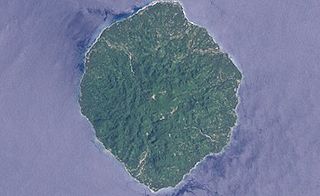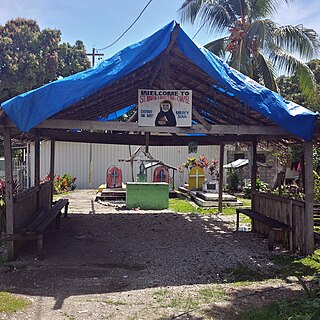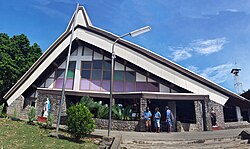
Solomon Islands is a sovereign state in the Melanesia subregion of Oceania in the western Pacific Ocean. This page is about the history of the nation state rather than the broader geographical area of the Solomon Islands archipelago, which covers both Solomon Islands and Bougainville Island, a province of Papua New Guinea. For the history of the archipelago not covered here refer to the former administration of the British Solomon Islands Protectorate, the North Solomon Islands and the History of Bougainville.

Guadalcanal is the principal island in Guadalcanal Province of Solomon Islands, located in the southwestern Pacific Ocean, northeast of Australia. It is the largest island in the Solomons by area and the second-largest by population. The island is mainly covered in dense tropical rainforest and has a mountainous hinterland.

Solomon Islands, also known simply as the Solomons, is a country consisting of 21 major islands Guadalcanal, Malaita, Makira, Santa Isabel, Choiseul, New Georgia, Kolombangara, Rennell, Vella Lavella, Vangunu, Nendo, Maramasike, Rendova, Shortland, San Jorge, Banie, Ranongga, Pavuvu, Nggela Pile and Nggela Sule, Tetepare, and over 900 smaller islands in Melanesia, part of Oceania, to the northeast of Australia. It is directly adjacent to Papua New Guinea to the west, Australia to the southwest, New Caledonia and Vanuatu to the southeast, Fiji, Wallis and Futuna, and Tuvalu to the east, and Nauru and the Federated States of Micronesia to the north. It has a total area of 28,896 square kilometres, and a population of 734,887 according to the official estimates for mid 2023. Its capital and largest city, Honiara, is located on the largest island, Guadalcanal. The country takes its name from the wider area of the Solomon Islands archipelago, which is a collection of Melanesian islands that also includes the Autonomous Region of Bougainville, but excludes the Santa Cruz Islands.

Savo Island is an island in Solomon Islands in the South Pacific ocean. Administratively, Savo Island is a part of the Central Province of Solomon Islands. It is about 35 kilometres (22 mi) from the national capital of Honiara. The principal village is Alialia, in the north of the island.
Solomon Islands is divided into nine provinces. The national capital, Honiara, on the island of Guadalcanal, is separately governed as the country's Capital Territory.

The Solomon Islands Football Federation is a member of the Oceania Football Confederation. The Solomon Islands national football team made history when they made it to the final Oceania stages of the 2006 World Cup Qualification against Australia. Before the tournament began it was almost presumed this place would go to New Zealand.

The Catholic Church in Solomon Islands is part of the worldwide Catholic Church, under the spiritual leadership of the Pope in Rome.

The Archdiocese of Honiara is a Latin Church ecclesiastical territory or archdiocese of the Catholic Church in the Solomon Islands. It is the successor of the apostolic prefecture of the British Solomon Islands, which was erected in 1897. The ecclesiastical province of Honiara was created in 1978, the first such creation of Pope John Paul II, and contains two suffragan sees: Gizo and Auki (1982).

White River is a suburb on the fringe of Honiara, Solomon Islands and is located 3 kilometres (1.9 mi) west of the main center on the Tandai Highway. White River is in the Honiara City Council ward of Nggosi. A water spring supplies water to the community.

Honiara is the capital and largest city of Solomon Islands, situated on the northwestern coast of Guadalcanal. As of 2021, it had a population of 92,344 people. The city is served by Honiara International Airport and the seaport of Point Cruz, and lies along the Kukum Highway. In 1983, a Capital Territory – comprising the 22 square-kilometre metropolitan area of Honiara – was proclaimed, with a self-governing status akin to a province, although the city also retained an older role as capital of Guadalcanal Province.

Point Cruz is a peninsula in the center of Honiara, on Guadalcanal Island. Honiara is the capital city of the Solomon Islands. Point Cruz is located on the Tandai Highway, and is ¼ mile north of the Solomon Islands Parliament Building. Point Cruz is in the Honiara City Council ward of Cruz, and is East of Town Ground and West of Tuvaruhu.

Tandai is a suburb of Honiara, in the Solomon Islands, located 2 kilometres (1.2 mi) west of the main center on the Tandai Highway. Tandai is in the Honiara City Council ward of Nggosi.

Rove is a suburb in Honiara located 2 kilometres (1.2 mi) west of the main center on the Tandai Highway. Rove borders the Honiara City Council ward of Nggosi and Rove-Lengakiki.
Town Ground is a suburb in Honiara, Solomon Islands, located in the main center on the Tandai Highway. Town Ground is in the Honiara City Council ward of Nggosi and Rove-Lengakiki.
Kakabona (Kakambona) is a peri-urban suburb on the fringe of Honiara, Solomon Islands and is located 4 kilometres (2.5 mi) west of the main center and west of White River on the Tandai Highway. Kakabona borders the Honiara City Council ward of Nggosi. Refugees from Bouganville settled following the conflict.
The 2009–10 Solomon Islands National Club Championship was the 7th season of the National Club Championship in the Solomon Islands. Koloale won the league for the third time and also qualified as the Solomon Islands representative for the 2010–11 OFC Champions League through the 2011 Solomon Islands Champions League Playoff against Solomon Warriors. All matches were played at the hillside ground called Lawson Tama Stadium, with an approximate capacity of 20,000.

The Honiara Central Market is a fish, flower, clothing, fruit and vegetable market, which also sells shell money, and other local crafts such as palm-frond broomsticks, jewellery, coconut oil and hair tonics in Honiara, the capital of Solomon Islands; offering the largest fresh produce and fish outlets of the country. The market "dominates" the national internal trade, starting from early after its creation in the 1950s, and up until today.

The Holy Cross Cathedral, also referred to as the Catholic Cathedral of Honiara, is the cathedral church and seat of the Metropolitan Archdiocese of Honiara. It is located in the city of Honiara, which is on Guadalcanal Island and is the capital of the Solomon Islands, a country in the southwest Pacific Ocean.

On 5 June 2000, a coup d'état occurred in Solomon Islands, in the capital of Honiara, in which the prime minister, Bartholomew Ulufa’alu, was taken hostage by militants of the Malaita Eagle Force. The event came as a result of longstanding ethnic tensions between the province that saw a rise in armed political groups from the late 1990s.
The Honiara City Council is an organisation that looks after the municipal affairs of Honiara, the capital city of the Solomon Islands on Guadalcanal Honiara is divided into twelve wards, each of which elect one councillor. There are eight extra councillors. Four are appointed by the Solomon Islands Minister of Home Affairs, and members of parliament representing the city are included, along with the premier of Guadalcanal province. The assembled council selects a mayor from one of the elected twelve.




























